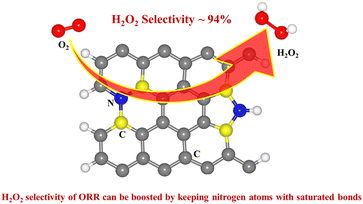New strategies to improve two-electron oxygen reduction reaction selectivity of polypyrrole-based catalysts†
Abstract
Direct electrochemical synthesis via the two-electron oxygen reduction reaction (ORR) is considered an environmentally friendly means to produce hydrogen peroxide (H2O2). Metal-free N-doped carbon materials are reported to display good electrocatalytic performance for H2O2 generation. Herein, we found that selectivity toward H2O2 production in the ORR can be further enhanced once the N atoms are saturated bonds in polypyrrole. Saturation can either be achieved by stabilizing the N–H bonds via hydrogen-bonding interactions during preparation or transforming the deprotonated nitrogen species into C–N bonds by calcining polypyrrole at appropriate temperatures. Eventually, our synthesized catalyst NPC-400 exhibits a 94% H2O2 selectivity and impressive stability. The mechanisms are elucidated by using control experiments and density-functional theory calculations. The α carbon atoms of pyrrolic-N are the active sites for selective H2O2 production. However, once the N atoms are not saturated, the OOH* intermediate species tend to bond with the N atoms, leading to relatively poor reaction selectivities. Our work provides new insight for designing high selectivity catalysts for H2O2 generation in the oxygen reduction reaction.

- This article is part of the themed collection: 2023 Journal of Materials Chemistry A HOT Papers


 Please wait while we load your content...
Please wait while we load your content...